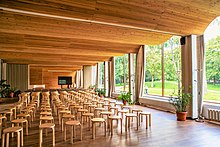

Vyborg Library (Finnish: Viipurin kaupunginkirjasto) is a library in Vyborg, Russia, built during the time of Finnish sovereignty (1918 to 1940-44), before the Finnish city of Viipuri was annexed by the former USSR and its Finnish name was changed to Vyborg by the Soviet authorities.
The building, built from 1927 to 1935, is an internationally acclaimed design by the Finnish architect Alvar Aalto and one of the major examples of 1920s functionalist architectural design. The library is considered one of the first manifestations of "regional modernism".[2] It is particularly famous for its wave-shaped ceiling in the auditorium, the shape of which, Aalto argued, was based on acoustic studies.[3] On completion the library was known as Viipuri Library, but after the Second World War and Soviet annexation, the library was renamed the Nadezhda Krupskaya Municipal Library. Nowadays, integrated in the Russian Federation city of Vyborg, the library is officially known as the Central City Alvar Aalto Library.
The library restoration project lasted almost two decades from 1994 until late 2013.[4] The restoration work was awarded with the World Monuments Fund / Knoll Modernism Prize in 2014 and the Europa Nostra Award in 2015.
- ^ Petra Ceferin, Constructing a Legend: The International Exhibitions of Finnish Architecture 1957–1967. SKS, 2003. ISBN 978-951-746-542-7
- ^ Christian Norberg-Schulz. Nightlands: Nordic Building. MIT Press, 1997. ISBN 978-0-262-64036-7. Page 164.
- ^ Ola Wedebrunn et al. (ed), Technology of Sensations. The Alvar Aalto Vyborg Library. DOCOMOMO, Royal Danish Academy of Fine Arts, 2004. ISBN 978-87-7830-108-6.
- ^ Cite error: The named reference
hs-101013was invoked but never defined (see the help page).